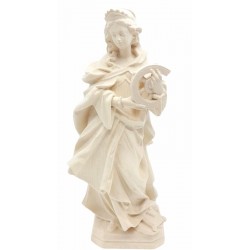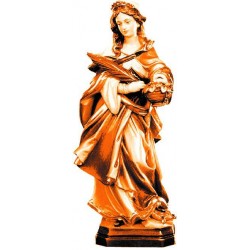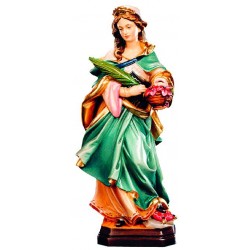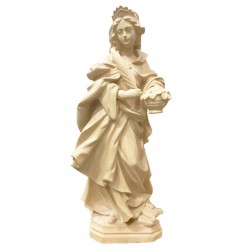Cart 0 Product Products (empty)
No products
To be determined Shipping
0,00 € Total
Product successfully added to your shopping cart
Quantity
Total
There are 0 items in your cart. There is 1 item in your cart.
Total products
Total shipping To be determined
Total
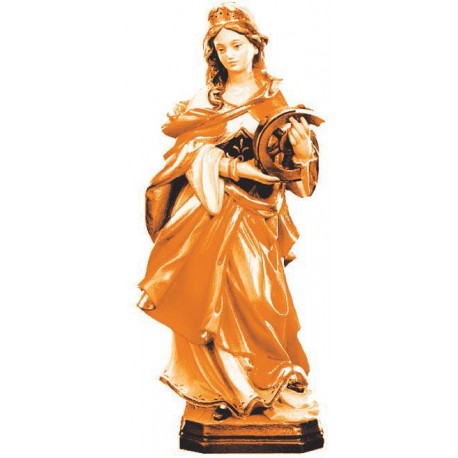 View larger
View larger Saint Catherine of Alexandria with wheel wood Carving - brown shades
New product
More info
Saint Catherine with wheel, Wood Carving Sculptures for Sale; S. Catherine of Alexandria Martyr
The texts of popular literature speak of Catherine as a beautiful eighteen-year-old Christian girl, daughter of nobles, living in Alexandria, Egypt. Here, in 305, Massimino Daia arrived, appointed governor of Egypt and Syria. For the occasion, grandiose festivities were celebrated, including the sacrifice of animals to pagan divinities. A compulsory act for all subjects. Catherine, however, invites Maximinus to recognize Jesus Christ as the redeemer of humanity and refuses the sacrifice. Not being able to convince the young woman to worship the gods, Maximin proposes marriage to Catherine. When Catherine refused, the governor condemned her to a horrible death: a large cogwheel would tear apart her body. A miracle will save the girl who will be decapitated. According to legend, angels will miraculously bring her body from Alexandria to Sinai, where even today the hill near Gebel Musa (Mountain of Moses) is called Gebel Katherin. This would have happened in November 305.
Feast day: November 25 - Optional Remembrance
Alexandria, III-IV centuries
Patronage: Philosophers, Students, Millers
Etymology: Catherine = pure woman, from Greek
Emblem: Ring, Palm, Wheel
Saint Catherine, according to tradition virgin and martyr in Alexandria, full of sharp wit, wisdom and strength of mind. Her body is the object of pious veneration in the monastery on Mount Sinai.
This is the elusive Catherine, without certain news of life and death. And she is the ubiquitous Catherine in Europe, for the diffusion of her cult, which then also influenced popular literature and folklore. Some texts written between the sixth and tenth centuries speak of her, that is, later than the year 305, indicated as the year of her death. And here is how her figure emerges from these stories full of fanciful details. Catherine is a beautiful eighteen-year-old Christian girl, daughter of nobles and lives in Alexandria.
Here, in 305, Massimino Daia arrived, appointed governor of Egypt and Syria (he proclaimed himself """"Augustus"""", that is emperor, in 307, dying by suicide in 313). For the occasion, grandiose festivities are celebrated, including the sacrifice of animals to pagan divinities. This was a compulsory act for all subjects, including Christians, who were still being persecuted. Catherine presents herself to Maximinus, inviting him to recognize instead Jesus Christ as the redeemer of humanity, and refusing the sacrifice.
Maximinus then summons a group of Alexandrian intellectuals to convince her to venerate the gods. But it was Catherine who convinced them to become Christians. Maximinus had them all killed for such a prompt conversion, then called Catherine back and even proposed marriage. Another refusal, more and more refusals, until the governor condemned her to a horrible death: a large cogwheel would tear apart her body.
A new miracle saves the young woman, who is then decapitated: but the angels miraculously bring her body from Alexandria to Sinai, where still today the hill near Gebel Musa (Mountain of Moses) is called Gebel Katherin. This takes place on November 24-25, 305. And some scholars believe that the legendary story indicates, by transfiguring it, an actual translation of the body on the mountain, but occurred at a later time. From the Gebel Katherin, finally, and at an unknown date, the remains were brought to the monastery dedicated to her, under that mountain.
Her biography is so unreliable that it contrasts with the reality of a widespread cult even outside Egypt. We find her depicted in the Roman basilica of San Lorenzo, in an 8th century painting with her name written vertically: Ca/te/ri/na; in Naples (10th-11th century) in the catacombs of San Gennaro, and later in many parts of Italy, as well as in France and in central-northern Europe, where she also inspired poems, sacred representations and """"cantari"""".
Her annual feast is seen primarily as the feast of youth. In France, Catherine became the patron saint of students of theology and the owner of many women's confraternities; and, in particular, the patron saint of seamstresses' apprentices, who took from her the name destined to last for a long time in Italy as well: """"Caterinette"""".
The texts of popular literature speak of Catherine as a beautiful eighteen-year-old Christian girl, daughter of nobles, living in Alexandria, Egypt. Here, in 305, Massimino Daia arrived, appointed governor of Egypt and Syria. For the occasion, grandiose festivities were celebrated, including the sacrifice of animals to pagan divinities. A compulsory act for all subjects. Catherine, however, invites Maximinus to recognize Jesus Christ as the redeemer of humanity and refuses the sacrifice. Not being able to convince the young woman to worship the gods, Maximin proposes marriage to Catherine. When Catherine refused, the governor condemned her to a horrible death: a large cogwheel would tear apart her body. A miracle will save the girl who will be decapitated. According to legend, angels will miraculously bring her body from Alexandria to Sinai, where even today the hill near Gebel Musa (Mountain of Moses) is called Gebel Katherin. This would have happened in November 305.
Feast day: November 25 - Optional Remembrance
Alexandria, III-IV centuries
Patronage: Philosophers, Students, Millers
Etymology: Catherine = pure woman, from Greek
Emblem: Ring, Palm, Wheel
Saint Catherine, according to tradition virgin and martyr in Alexandria, full of sharp wit, wisdom and strength of mind. Her body is the object of pious veneration in the monastery on Mount Sinai.
This is the elusive Catherine, without certain news of life and death. And she is the ubiquitous Catherine in Europe, for the diffusion of her cult, which then also influenced popular literature and folklore. Some texts written between the sixth and tenth centuries speak of her, that is, later than the year 305, indicated as the year of her death. And here is how her figure emerges from these stories full of fanciful details. Catherine is a beautiful eighteen-year-old Christian girl, daughter of nobles and lives in Alexandria.
Here, in 305, Massimino Daia arrived, appointed governor of Egypt and Syria (he proclaimed himself """"Augustus"""", that is emperor, in 307, dying by suicide in 313). For the occasion, grandiose festivities are celebrated, including the sacrifice of animals to pagan divinities. This was a compulsory act for all subjects, including Christians, who were still being persecuted. Catherine presents herself to Maximinus, inviting him to recognize instead Jesus Christ as the redeemer of humanity, and refusing the sacrifice.
Maximinus then summons a group of Alexandrian intellectuals to convince her to venerate the gods. But it was Catherine who convinced them to become Christians. Maximinus had them all killed for such a prompt conversion, then called Catherine back and even proposed marriage. Another refusal, more and more refusals, until the governor condemned her to a horrible death: a large cogwheel would tear apart her body.
A new miracle saves the young woman, who is then decapitated: but the angels miraculously bring her body from Alexandria to Sinai, where still today the hill near Gebel Musa (Mountain of Moses) is called Gebel Katherin. This takes place on November 24-25, 305. And some scholars believe that the legendary story indicates, by transfiguring it, an actual translation of the body on the mountain, but occurred at a later time. From the Gebel Katherin, finally, and at an unknown date, the remains were brought to the monastery dedicated to her, under that mountain.
Her biography is so unreliable that it contrasts with the reality of a widespread cult even outside Egypt. We find her depicted in the Roman basilica of San Lorenzo, in an 8th century painting with her name written vertically: Ca/te/ri/na; in Naples (10th-11th century) in the catacombs of San Gennaro, and later in many parts of Italy, as well as in France and in central-northern Europe, where she also inspired poems, sacred representations and """"cantari"""".
Her annual feast is seen primarily as the feast of youth. In France, Catherine became the patron saint of students of theology and the owner of many women's confraternities; and, in particular, the patron saint of seamstresses' apprentices, who took from her the name destined to last for a long time in Italy as well: """"Caterinette"""".






